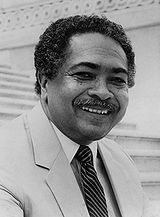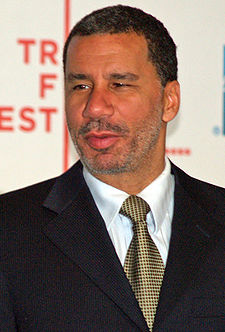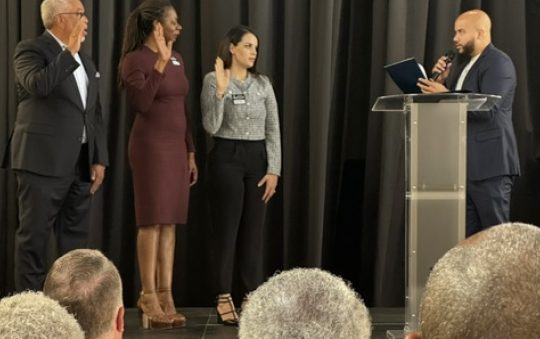

Oscar J. Dunn, Alonzo J. Ransier, Caesar “CC” Antoine



George L. Brown, Mervyn M. Dymally, Jennette B. Bradley


Michael S. Steele, Anthony G. Brown, David A. Paterson
A lieutenant governor in the United States is the highest officer of a state after the governor, and he/she stands in for the governor when he/ she is absent from the state or is incapacitated–dies, resigns or is removed from office. Many states have lieutenant governors with varying functions and methods of succession. With few exceptions, the lieutenant governor automatically becomes governor by law, appointment or as acting governor until the next or special election. There have been 11 Black lieutenant governors in the U.S.; some ascended to become governors and others were elected as lieutenant governors. During the 19th century, they were all Republicans and three of the four were from Louisiana. In the 20th century, there were three and were all Democrats. And thus far in the 21st century, there have been four: two Democrats and two Republicans. Two of the have been from the state of Maryland.
19th Century
Oscar J. Dunn was the first Black lieutenant governor in the U.S.; he was elected in the state of Louisiana and served from 1868 to 1871. Dunn was a self-educated man who rose from slavery and purchased his own freedom. He also served in Union Army for the First Louisiana Guard during the Civil War and rose to the rank of captain. He played a vital role in the post- Civil War era in Louisiana speaking at mass meetings where he would demand equality and suffrage for Blacks particularly in the state government. Dunn was one of the Blacks who attended the convention that drafted Louisiana’s constitution in 1868 and was elected lieutenant governor on the Republican ticket. He presided over the senate and developed a distaste for graft and corruption in office, which placed him in a strong position to become the next governor of the state. However in 1871, Dunn died suddenly and mysteriously after serving three years in office.
Though, Pinckney Benton Stewart “P.B.S” Pinchback is remembered as the nation’s first Black governor, upon Dunn’s death, Pinchback became acting lieutenant- governor of Louisiana. (Like Dunn, he too was a captain in the U.S. Army and after the war became active in the Republican Party, attended the 1868 convention and was elected state senator).
During the same period, Alonzo J. Ransier–born a free Black man–became a shipping clerk before being appointed the state registrar of elections in South Carolina in 1865. The following year, he attended the state’s first Republican convention which helped to establish its first racially integrated government. Ransier also held a series of political posts during the Reconstruction era including state representative before being elected lieutenant-governor in 1870. There he served for two years and was then elected a Republican Congressman. He served in Congress from 1873 to 1875 fighting tirelessly for civil rights.
After leaving Congress, he returned to Charleston, worked for the Internal Revenue Service and later for the Charleston municipal government. Ransier died in Charleston on August 17, 1882.
Caesar Carpenter “C.C.” Antoine was born in New Orleans to a Black father and a West Indian mother. His grandmother was from Africa, the daughter of a captured African chief, who bought her own freedom and became an acute businesswoman. Her minor fortune allowed Antoine and his father to operate a successful grocery business and to live out their lives as free Blacks. During the Civil War, he joined the Union Army and quickly rose to the rank of Captain. At the end of the Civil War, Antoine moved to Shreveport, Louisiana, opened a family grocery store, bought land and became a farmer. He soon entered politics and held his first office as a delegate to Louisiana’s Constitutional Convention in 1868. Under the protection of federal troops, black voting rights were established and Antoine became a Republican state senator serving from 1868 to 1872. He then became lieutenant-governor in 1872–briefly acting as governor in 1876–until 1877. His tenure ended soon after the Compromise of 1877 which withdrew federal troops from Louisiana, allowing the Democrats to return to power. Though he remained active in party politics, he never again held public office. In 1921, Antoine died of natural causes at his home in Shreveport.
20th Century
In 1974, George L. Brown and Mervyn M. Dymally were the first two lieutenant-governors elected in 20th century in Colorado and California respectively. Brown was born in July 1926, in Lawrence, Kansas, on a farm and he was a star athlete in basketball, football and track before graduating from high school in 1944. During World War II, he served as a Tuskegee Airman. Though they were sworn in within an hour of each other in 1975, their beginnings were miles apart. Dymally was born in Cedros, Trinidad, an island/country in the then British West Indies.
They both started off with degrees in journalism. Brown also did graduate work at Harvard Business School, the University of Colorado and the University of Denver. He worked as a writer, was the first Black editor at The Denver Post and hosted his own radio talk show. Brown served as the assistant executive director for Denver’s Public Housing Program for four years and taught at the University of Colorado and the University of Denver. Brown started in politics in 1955 as a member of the Colorado House of Representatives and the state senate where he served a total of 18 years. Then in 1974, during his 5th term as a state senator, he was elected as lieutenant-governor, the first in the nation in the 20th century.
Dymally received his secondary education in Trinidad, did his undergraduate at Lincoln University, Jefferson City, Missouri and Los Angeles State College, his Master’s degree from California State University, Sacramento, and his doctorate from United States International University (now Alliant International University), San Diego. He entered politics as a California State Assemblyman in 1963 and as the first Black State Senator (1967-1975). In 1974, he was elected as California’s first Black lieutenant-governor. He also served in the U.S. House of Representatives (1981-1993) and after a 10-year retirement, returned to politics as a California State Assemblyman (2002-2008).
Brown and Dymally’s careers as lieutenant-governors seemed to have traveled parallel historical paths. In addition to the close proximity of them being elected and sworn in, they each served one torturous and embattled four-year term. Brown, the nation’s first African American lieutenant governor of the 20th century, died March 2006 at his home in Boca Raton, Florida. Dymally, though out of politics after half a century, is presently the director of the Urban Health Institute at Charles Drew University of Medicine and Science.
L. Douglas Wilder is well known as the first Black governor to ever be elected the governor of a U.S. state; he served as governor of Virginia from 1990 to 1994. Born January 17, 1931, he began his career in politics as a state senator in 1969 where he served until 1985 when he was narrowly elected as the state’s lieutenant-governor, the first African-American to be elected to a statewide office. Since leaving the governor’s office, he has been elected mayor of Richmond, Virginia, a position he presently holds.
21st Century
In 2003 at the dawn of the 21st century, Jennette Bradley of Ohio and Michael S. Steele of Maryland became lieutenant-governors of their respective states. She, not only was the first African American to serve in that capacity in her state, but she was also the first Black woman ever elected as lieutenant-governor in the history of the United States. He was the first African American to be elected in that capacity in his state. They were both Republicans.
Jennette B. Bradley earned a Bachelor’s degree from Wittenberg University in Springfield, Ohio and started her career as an executive at a banking company. She entered the political arena as a member of the city council of Columbus, Ohio, where she served for 11 years.
In 2002, Governor Bob Taft of Ohio placed Bradley on his gubernatorial ticket as lieutenant-governor since his previous lieutenant-governor decided to run for another officer. That move sparked protests from his own party on the grounds that Bradley was too liberal, having supported abortion and homosexual rights. However, the ticket prevailed. From 2003 to 2005, she and Steele were the two highest-ranking African American Republicans in the United States.
Born in 1958 at Andrews Air Force Base, Steele attended a Roman Catholic school in the Washington D.C. area eventually winning a scholarship to John Hopkins University. He later on earned a law degree at Georgetown University and worked as a corporate lawyer through much of his career before entering politics. Though he grew up in a Democratic household, he switched to the Republican Party as an adult. Steele worked on several political campaigns until he was chosen to attend the Republican National Conventions as an alternate delegate in 1996 and 2000. He also became the chairman of the Maryland Republican Party, the first African American to be so named.
In 2002, Steele was chosen as a running mate and nominee for Lieutenant Governor in the campaign against Democrat Kathleen Kennedy Townsend, who was then the Lieutenant Governor of Maryland. He resigned his chairmanship of the Maryland Republican Party to campaign full-time and was described as bringing “little to the team but the color of his skin.”
The top statewide tickets in Ohio and Maryland won, and Bradley and Steele were elected lieutenant-governors of their respective states. Like Brown and Dymally in 1975, they were both sworn in, in 2003. Bradley was sworn in on January 13, 2003 and Steele, on January 15, 2003. She served from 2003 to 2005, resigning in 2005 to become Ohio State Treasurer. Afterwards, Bradley became involved with the Girl Scouts Council.
Steele served from 2003 to 2007. Since leaving office, he remained active in Republican politics. He ran unsuccessfully for the U.S. Senate seat for Maryland and is currently serving as the first African American chairman of the Republican National Committee.
Anthony G. Brown is currently the lieutenant-governor of Maryland having succeeded Steele. A member of the Democratic Party, he was elected in 2006 and was sworn in the following January. Brown was born in New York and is the highest-ranking elected official in the nation to have served a tour of duty in Iraq. He is a 25-year veteran of the U.S. Army and a colonel in the U.S. Army Reserve.
He attended public school on Long Island, graduating from Huntington High School in 1979. After high school, Brown attended Harvard College, where he enrolled in the U.S. Army ROTC program at MIT. Brown spent five years in active duty with the U.S. Army before enrolling in Harvard Law School, where he was a year behind President Barack Obama.
Brown first entered politics when he was elected to the Maryland House of Delegates in 1998 representing Prince George’s County District 25. There he focused heavily on veterans-oriented issues and legislation. He ran on the gubernatorial ticket in 2007 and won defeating the incumbent(s). He was sworn in as the state’s 8th lieutenant-governor on January 17, 2008,
David A. Paterson is currently the governor of the state of New York. He ascended to that position in 2008 when the governor resigned and he was the lieutenant-governor. He was 54 years at the time with an outstanding record of public service; he is also legally blind and has been since birth.
The son of a former N.Y. state senator, Paterson brought to both the governor’s and lieutenant-governor’s offices, a long record of effective leadership and public service making history among Black elected officials in the State of New York. He earned his law degree from Hofstra Law School in 1983 and entered public service as a New York State Senator representing Harlem in 1985 becoming its Minority Leader and the first non-White legislative leader in New York’s history. Paterson gained national attention in the 1990s when he worked to preserve an African American burial ground that was discovered at a pending new construction site by securing federal funds to preserve the site saying, “through the discovery of the African American Burial Grounds, our history has at last come to the surface for all of us to know and respect.”
In 2004, he became the first visually impaired person to address the Democratic National Convention and in 2006, he was elected New York’s first African-American lieutenant governor. As lieutenant-governor, he continued to champion the important legislative issues that he did as a state senator including stem cell research, alternative energy, reducing domestic violence and increasing the role minority and women-owned businesses play in New York State. When he was on the threshold of becoming the state’s first Black governor, he told a New York newspaper, “You never get to any level of leadership where your race is not a factor. You don’t want to be the first; you want to be the first of many.”
Â






